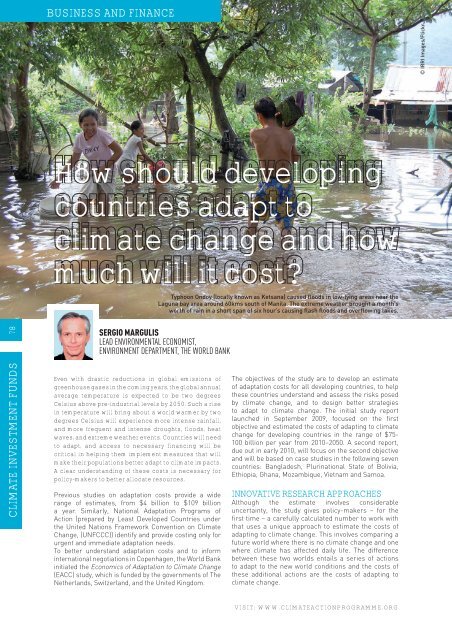Climate Action 2009-2010
You also want an ePaper? Increase the reach of your titles
YUMPU automatically turns print PDFs into web optimized ePapers that Google loves.
BUSINESS AND FINANCE<br />
© IRRI Images/Flickr<br />
How should developing<br />
countries adapt to<br />
climate change and how<br />
much will it cost?<br />
Typhoon Ondoy (locally known as Ketsana) caused floods in low-lying areas near the<br />
Laguna bay area around 60kms south of Manila. The extreme weather brought a month’s<br />
worth of rain in a short span of six hour’s causing flash floods and overflowing lakes.<br />
CLIMATE INVESTMENT FUNDS 78<br />
Sergio MarguliS<br />
Lead environmentaL economist,<br />
environment department, the WorLd Bank<br />
Even with drastic reductions in global emissions of<br />
greenhouse gases in the coming years, the global annual<br />
average temperature is expected to be two degrees<br />
Celsius above pre-industrial levels by 2050. Such a rise<br />
in temperature will bring about a world warmer by two<br />
degrees Celsius will experience more intense rainfall,<br />
and more frequent and intense droughts, floods, heat<br />
waves, and extreme weather events. Countries will need<br />
to adapt, and access to necessary financing will be<br />
critical in helping them implement measures that will<br />
make their populations better adapt to climate impacts.<br />
A clear understanding of these costs is necessary for<br />
policy-makers to better allocate resources.<br />
Previous studies on adaptation costs provide a wide<br />
range of estimates, from $4 billion to $109 billion<br />
a year. Similarly, National Adaptation Programs of<br />
<strong>Action</strong> (prepared by Least Developed Countries under<br />
the United Nations Framework Convention on <strong>Climate</strong><br />
Change, (UNFCCC)) identify and provide costing only for<br />
urgent and immediate adaptation needs.<br />
To better understand adaptation costs and to inform<br />
international negotiations in Copenhagen, the World Bank<br />
initiated the Economics of Adaptation to <strong>Climate</strong> Change<br />
(EACC) study, which is funded by the governments of The<br />
Netherlands, Switzerland, and the United Kingdom.<br />
The objectives of the study are to develop an estimate<br />
of adaptation costs for all developing countries, to help<br />
these countries understand and assess the risks posed<br />
by climate change, and to design better strategies<br />
to adapt to climate change. The initial study report<br />
launched in September <strong>2009</strong>, focused on the first<br />
objective and estimated the costs of adapting to climate<br />
change for developing countries in the range of $75-<br />
100 billion per year from <strong>2010</strong>–2050. A second report,<br />
due out in early <strong>2010</strong>, will focus on the second objective<br />
and will be based on case studies in the following seven<br />
countries: Bangladesh, Plurinational State of Bolivia,<br />
Ethiopia, Ghana, Mozambique, Vietnam and Samoa.<br />
INNOVATIVE RESEARCH APPROACHES<br />
Although the estimate involves considerable<br />
uncertainty, the study gives policy-makers – for the<br />
first time – a carefully calculated number to work with<br />
that uses a unique approach to estimate the costs of<br />
adapting to climate change. This involves comparing a<br />
future world where there is no climate change and one<br />
where climate has affected daily life. The difference<br />
between these two worlds entails a series of actions<br />
to adapt to the new world conditions and the costs of<br />
these additional actions are the costs of adapting to<br />
climate change.<br />
V I SIT: WWW.CLIMATEACTIONPROGRAMME.ORG












